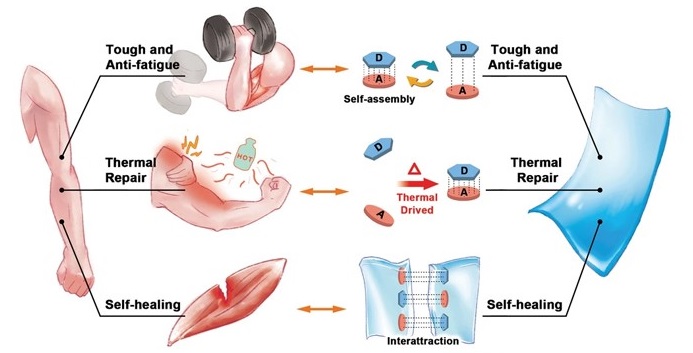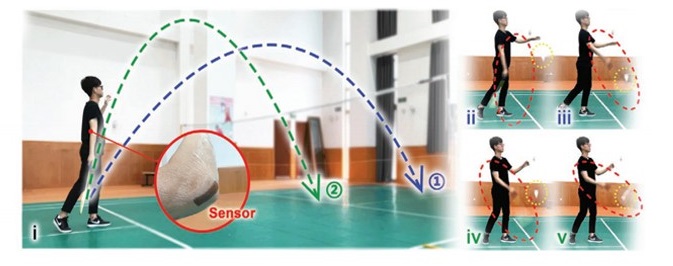A research group led by Prof. ZHU Jin at the Ningbo Institute of Materials Technology and Engineering (NIMTE) of the Chinese Academy of Sciences (CAS) developed a polyurethane with excellent properties of stretchability, toughness, self-healing and even thermal repair, which mimic the biological functionalities of human muscles. The study was published in Advanced Functional Materials.
As an increasingly valuable frontier for the next generation of electronic devices, stretchable electronics can conform to various soft and curved shapes, thus they are expected to play a more constructive role in the age of artificial intelligence and trigger greater changes to people’s daily life.
Elastomers are incorporated into the stretchable electronics and endow them with varying mechanical properties or even additional features like self-healing to maintain the durability and stability of stretchable electronics. However, the trade-off between mechanical properties (i.e. stretchability and toughness) and self-healing limits the optimization of overall properties of elastic matrix.
Inspired by the biological properties of human muscles, researchers at NIMTE synthesized a polyurethane (DA-PU) for stretchable electronics, which contains donor and acceptor groups alternately distributed along the main chain to achieve both intra-chain and inter-chain D–A self-assembly.
By virtue of the skeletal muscle protein titin, human muscles can perform hundreds of concentration/relaxation cycles in short time. The intramolecular secondary interactions of titin can be reversible ruptured and refold to recover the muscle.
Similarly, thanks to the reversible D–A self-assembly, DA-PU could perform the same or more concentration/ relaxation cycles without permanent deformation. The D–A self-assembly stabilized the network structure composed of soft and hard phases in polyurethane, rendering it as hyperelastic, super-tough, and durable as human muscles.
In detail, DA-PU exhibited amazing mechanical performances with the elongation at break of 1900% and toughness of 175.9 MJ m-3. Besides, cyclic tensile and stress relaxation experiments proved the remarkable anti-fatigue and anti-stress relaxation properties of DA-PU. Even in case of deformation under large strain or long-time stretch, it could be almost completely restored by thermal repair at 60℃. In addition, the self-healing speed of DA-PU achieved 1.0–6.15 μm min-1 from 60 to 80 °C, which was gradually enhanced as the temperature increased.
Moreover, researchers fabricated a stretchable capacitive sensor based on DA-PU, which showed remarkable stretchability, anti-fatigue and self-healing properties even after critical deformation and cut off.
The strategy may shed light on the research and development of a series of tough and self-healing elastic materials applied in the field of stretchable electronics.

Fig. The muscle-inspired super-tough, anti-fatigue, thermal reparable and self-healable DA-PU elastomers (Image by NIMTE)

Fig. The stretchable capacitive sensor based on DA-PU (Image by NIMTE)
Contact
YING Wubin
Ningbo Institute of Materials Technology and Engineering
E-mail: yingwubin@nimte.ac.cn

